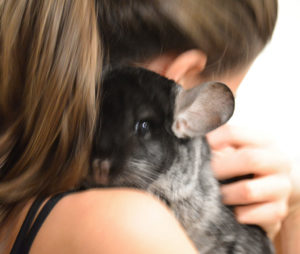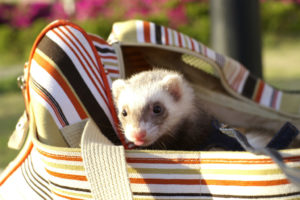Chinchillas and ferrets both have their own descriptions as animals. The very same can be said about them being pets. They are not two pet companions that you can probably have in the same room together. Because you just don’t put them together. It would be like putting oil and water together. They would never mix. Ferrets are predators and hunters. Chinchillas are rodents and prey. They are two totally different types of animals. The very same can be said about each one of them becoming a family pet.
Ferrets and chinchillas have their own ways as animals and living creatures. Therefore, with all of this said, who makes for the best pet? Is it the chinchilla or ferret? What is the answer or answers here? Answers don’t come easy. They will be explored here in truth and in depth for all to get to know. Please read on to learn more. The information presented here will help an individual to make the best pet choice that works for them.
However, before making any decisions on a chinchilla or ferret, it is wise to know a little bit more about each animal in depth first. This is why some facts will be highlighted here on both chinchillas and ferrets equally as animals and pets. The information gathered will be the thing that will help a pet owner, or person interested in both animals, to arrive at the best decision all around for one as his or her final pet choice.
Chinchilla Specific Characteristics

Baby Chinchilla by Chinchillafactssite.com (CC BY)
The chinchilla is a breed of rodent that is native to Andes Mountains that are located in the northern area of Chile. Ancestors of the original chinchillas were the first rodents of their kind to infest South America.
These little animals are prized for their very soft and wonderful fur. This is why the species was nearly driven to extinction at one point. The demand for their very special fur was so great. Chinchilla fur in the wild was once yellowish-gray in color. However, through selective breeding of them, other colors have since become available. The palette of colors includes silver or yellow-gray, bluish-gray; white, beige and black. It doesn’t matter what the main color is. Their hair tips always do end in black.
The fur of the chinchilla is something that started to become immensely popular in the 1700s. The poor animals were nearly hunted to the point of almost total extinction by the 1900s. Just about this time, many Latin countries started to put a ban on hunting wild chinchillas for their fur.
Information obtained from the chinchilla chronicles website online does state the following about how chinchillas did make their way to the United States. There was a certain American mining engineer named Mathias F. Chapman who did make a request from the Chilean government. This request was for him to bring chinchillas to the United States in 1923. Chapman was able to take eleven chinchillas with him. They were the early ancestors to nearly every pet chinchilla that is now in America.
The physical characteristics of chinchillas do include short forelimbs and long muscular hind legs. They are also related to guinea pigs and porcupines. They are said to resemble rabbits as well. Nonetheless, the exotic rodents have much shorter ears, which are very much rounder than that of rabbits. They also possess dark black eyes and have bushy tails. Chinchillas are also not that big as bunnies. They are about somewhere in between 9 to 15 inches long and their tail can add on an additional three to 5 inches at times. They can weigh in between 1.1 to 1.8 pounds each. Each chinchilla does have four toes on each foot. These four toes have thin claws that are completely surrounded by stiff bristles that do give them a hairy sort of look about them.
What are some good qualities about chinchillas? They have far more than just a beautiful and soft furry coat. They also are very inquisitive animals and do have a boisterous nature. One of the downsides of chinchillas is that they are very high strung and they have short attention spans. They also don’t tolerate hot or humid weather at all.
Ferrets Specific Characteristics

Ferrets are animals that don’t make good pets for everyone. They can only make great pets for the right owners. They are very affectionate and do bond with those who own them. They are also very playful as pets too. They are also quiet for a big part of the day. For some reason or other, they have managed to earn a bad reputation for themselves, in certain places. Nonetheless, they are every inch, the fascinating animal and pet.
A pet ferret is also called the domesticated ferret. The species is a member of the weasel family and is also descended from the European polecat. There are other members that make up the weasel family besides the ferret. Some of these other family members do include the minks, otters, and the very rare Black-Footed Ferret. Domestic ferrets are an animal that has been domesticated for thousands of years in time. They are not wild animals at all. They were once used as working animals and still are in some places around the world. One of these countries is the United Kingdom. What they do is help to get rid of rodents from barns and to flush rabbits from their dens. This flushing out of rabbits is called ferreting. The ferrets that live in the United States are just beloved house pets.
Ferrets can make wonderful, loyal, affectionate, intelligent, and loving pets. They love to play and do lots of hilarious things that can make people laugh very hard. They have mischievous eyes and very sweet looking face. On the other side, they can also be aggressive when they want to be. They need to live in a safe environment. Ferret pet parents have to protect their house from damage by the extremely active and playful household anmials.
Ferrets can make great pets for some. They aren’t pets for everyone. The very same thing can be said about chinchillas. Therefore, which one makes the best pet overall, is a decision that only a potential pet owner of either of these two animals can decide for themselves.
Editor’s Recommendations
- Chinchilla Facts – livescience.com
- Feeding and Caring for Your Pet Ferret – cvm.msu.edu
